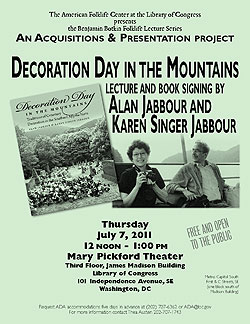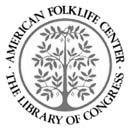| |
|||
|
|
The American Folklife Center at the Library of Congress July 7, 2011 Event Flyer Decoration Day in the MountainsPresented by Alan Jabbour and Karen Singer Jabbour
Decoration Day is a widespread cultural tradition in a swath of the American South extending from east of the Appalachians to west and southwest of the Ozarks. In the fullest form of the tradition, people visit a cemetery where family members are buried to provide an annual or periodic cleaning. Then they decorate the graves with flowers and other symbols of affection. Finally, they gather as a family or community in a religious service in the cemetery reaffirming their connections with each other and with the community beneath the ground. The service may involve preaching, prayers, hymn singing, and a ritual meal known as "dinner on the ground." Decoration Day — its practitioners often call the event simply a "decoration" — is a powerful ritual of piety. At the practical level, it provides a cultural motivation for cleaning and repairing a cemetery, which, if not properly maintained, can be reclaimed by the forest of the Upland South with astonishing speed. At the social level, it serves as a focal point for gathering a community, and it has long provided an occasion for community members from afar to return to their homeplace. At the deepest spiritual level, a decoration is an act of respect for the dead that reaffirms one’s bonds with those who have gone before. One would think that such a widespread folk custom, practiced by or at least known to hundreds of thousands of Americans, would by now have generated an extensive literature. But till now there has been no book-length treatment of the tradition, and the articles that discuss it are mostly localized and limited in their perspective on what is a broadly diffused and greatly varied regional tradition. Further, the complicated relation of this cultural tradition to the national Memorial Day, which began in the Northern states after the Civil War, continues to confuse everyone from encyclopedia writers to local practitioners. This presentation examines the historical origins and geographic sweep of Decoration Day and presents some surprising connections and comparative details to help explicate its history. Decorating graves with flowers is of course an ancient cultural practice, but the particular practice of Decoration Day portrayed here seems to emerge from the mists of time during the middle decades of the nineteenth century in the American South. Though this presentation deals with the historical origins and geographic spread of Decoration Day, its main focus is on a subregion of the Upland South where the tradition seems particularly strong. That subregion is a multicounty area of Appalachian North Carolina west of Asheville — Swain, Jackson, and Graham Counties and, to a lesser extent, the counties surrounding them. It is a region where two great mountain ranges converge — the Balsam Mountains and the Great Smoky Mountains. Here many cemeteries hold decorations, and local people are well aware of the cultural tradition of cemetery decoration. Here, too, the tradition of cemetery decoration has been at the root of a tug-of-war between local citizens and the federal government that has lasted for a half century. When Fontana Dam was built (1941– 44), a large number of people were removed from their homes in the valley of the Little Tennessee River and along the creeks flowing down the southern flank of the Great Smoky Mountains. The land between the ridge of the Smokies and the thirty-mile-long dam lake became part of Great Smoky Mountains National Park. A document was created and disseminated in which the concerned national, state, and local governmental agencies agreed to build a new road on higher ground above the north shore of Fontana Lake. This road would provide access to the twenty-seven cemeteries surviving in the lands conveyed to the National Park Service. Part of that road was built in the 1950s and early 1960s, but then construction stopped and the road gained a new and by now legendary name, "The Road to Nowhere." How the ensuing tug-of-war developed, and how a new form of Decoration Day emerged in the cemeteries of the park’s "North Shore," comprise a special focus of this presentation. Although the presentation tells the compelling story of the North Shore cultural revolution, it places that revolution in the context of the wider practice of cemetery decoration outside the national park. There seems to be a symbiotic relationship between the decorations within the park and beyond the park boundaries. Taken together, these two forms of Decoration Day make western North Carolina one of the most varied and vibrant areas in the Upland South for this venerable and culturally powerful custom. Excerpted from Decoration Day In The Mountains: Traditions Of Cemetery Decoration In The Southern Appalachians by Alan Jabbour and Karen Singer Jabbour. Copyright 2010 by the University of North Carolina Press. Photographs copyright 2010 by Alan Jabbour and Karen Singer Jabbour. Used by permission of the publisher.
|
| ||||


 The American Folklife Center was created by Congress in 1976 and placed at the Library of Congress to "preserve and present American Folklife" through programs of research, documentation, archival preservation, reference service, live performance, exhibition, public programs, and training. The Center includes the American Folklife Center Archive of folk culture, which was established in 1928 and is now one of the largest collections of ethnographic material from the United States and around the world.
The American Folklife Center was created by Congress in 1976 and placed at the Library of Congress to "preserve and present American Folklife" through programs of research, documentation, archival preservation, reference service, live performance, exhibition, public programs, and training. The Center includes the American Folklife Center Archive of folk culture, which was established in 1928 and is now one of the largest collections of ethnographic material from the United States and around the world.